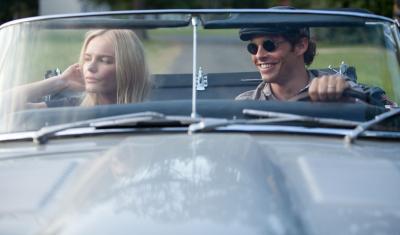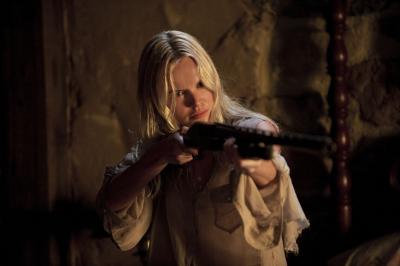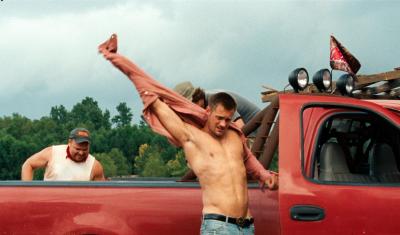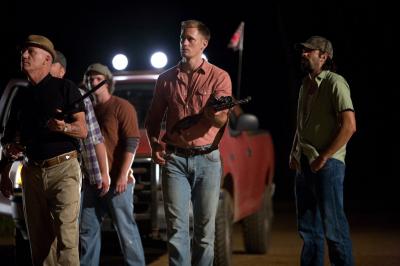By: debbie lynn elias

My admiration and respect for writer/director Rod Lurie runs deep. With a Lurie project, I am always guaranteed an intelligently written, intellectually and philosophically stimulating story that explores human behavior. Always capped with intrigue, tension and intensity, elements of violence also come into play, further lending to psychological exploration. I also have great respect and admiration for Sam Peckinpah, so, when Lurie announced that he was remaking Peckinpah’s classic STRAW DOGS, my interest was beyond piqued. Following Lurie’s journey from casting to lensing to music to post production, my excitement was almost uncontainable awaiting the final production. But, as they say, all good things come to those who wait and STRAW DOGS is worth the wait. An intelligently crafted and stimulating psychological battle of warfare, STRAW DOGS is punctuated with explosive shocking violence that stays with you long after the curtain closes. Where does savage violence begin and end? Where does humanity exist? Where is the breaking point of each?

David and Amy Sumner are your average Hollywood wannabe power couple. David, a screenwriter, is a passive, cerebral man, relying on brains over brawn for life’s journey. In fact, his current script is based on the psychology of the Russian Army in reclaiming Stalingrad when 90% Nazi occupied. Amy is a perky slender blonde actress who is Blackwater, Mississippi’s greatest gift and success story, although it seems her only known acting gig is a cancelled series that apparently only had viewers in Blackwater. Between roles, and with the passing of her father, and after hurricanes have ravaged the family homestead, Amy heads to Blackwater, with David in tow. Intending to take care of family business while David finishes his screenplay, the two come riding into town in their posh silver 1967 Jaguar XKE with credit cards at the ready. Sadly for David, Blackwater is a cash and carry town, something foreign to him.

On their arrival, Amy is immediately welcomed as the belle of the ball, especially by her ex-boyfriend, former football star, Charlie. With lust in his eyes, you can see Charlie wants to restake his claim on Amy, particularly given his obvious superior physicality to David. After all, why would she possibly want David when she could still be waiting tables in Blackwater catering to Charlie’s every desire? For David, he views the locals as nothing more than “straw dogs”. Similar to the straw offerings to the Gods in ancient China which were treated with great reverence in offering, but then tossed away and discarded when no longer needed, the locals may serve a purpose for a particular thing at a particular time, but when their day in the sun is done, so are they. Ouch.
As we meet the other locals, we learn of the culture. Each characterization speaks volumes as to the culture and lifestyle just with their individual manner and actions. No backstory explanation is needed, particularly with former football Coach Tom Heddon. An exceedingly violent man who drinks too much, Heddon knows the buttons to push with his former players, themselves frustrated and stuck in their prior days of football glory, giving rise to great needs to “blow off steam” and where everything is still viewed as a “high school prank.” And Heddon has his own Achilles’ Heel – his daughter – a randy little cheerleader who only wants to defy her father, particularly when it comes to the Jeremy Nils, a sweet but mentally challenged man.

With Amy playing her own mind games trying to stir something up between Charlie and David and force David to “defend her honor”, Charlie plays his own games driving a wedge between David and Amy, with everything exploding in the showdown to end all showdowns. With the entire town at the Friday night football game, Amy’s demons come crashing in on her while David crashes his car into Jeremy and Heddon’s daughter goes missing. In a climactic labyrinth of warfare, hell rises on earth.
I admit that I had doubts when James Marsden was cast as David. Assuming Dustin Hoffman’s role but now with David as a screenwriter instead of meek mild mathematician, the emotional transformation that Marsden brings to the evolution of David is fascinating to watch unfold. In some ways he reminds me of Patrick Swayze in “Roadhouse” – be nice, until it’s time not to be nice. Marsden is at his most compelling and most surprising. Kate Bosworth’s Amy is simply written and Bosworth serves well as a catalyst, spurring the testosterone war between David and Charlie, Charlie more than David, whose passive ways only antagonize Amy, prompting her to incite danger. Bosworth has this great sense of feminine indignance which she manipulates with an ease and fluidity. Notable is watching Marsden and Bosworth together, each imbues small subtleties that belie a “happy marriage” for Amy and David, thus setting their own stage for ambiguity and conflict.

As Charlie, Alexander Skarsgard is masterful walking a nuanced fine line of psychological intrigue. He commands the screen with a quiet physical intensity that has you begging for more, prompting one to want to understand what makes him tick, how does he maintain emotional control and then just turns on a dime. Riveting performance.
But the real stand out is James Woods as Coach Heddon. The most intensely disturbed and mesmerizing character of his career, Woods is a hot contender in the Best Supporting Actor category. As Heddon he is the hot button trigger that defines Blackwater and its people. Stuck in the past – just as Heddon’s “boys” have never left the high school mentality behind – his head to head with Marsden and Skarsgard is fascinating. I couldn’t take my eyes from the screen.
A complete contrast to the majority of the cast is Dominic Purcell who brings this beautiful innocent quiet elegance to Jeremy. A truly moving performance.

While Lurie retains the essential story and seminal visual moments from Peckinpah’s classic, for the true psychological essence of the piece, he harkens more to the original source material, Gordon William’s “The Siege of Trencher’s Farm.” By relocating the setting from England to the Deep South, the story and psychological and behavioral patterns are strengthened, defining the discussion on and drawing battle lines for physical savagery in the society of the 21st Century. He opens up the film and the elements of violence, providing believability for the mindset and actions of the locals (including Amy). With football and hunting a mainstay of the culture, no further explanation is needed as to why Charlie and company are such buffoons – they obviously suffered mental skewing from getting hit in the head too many times on the field, triggering unsolicited violent behavior – and they know no other way to live. Fear kept them from moving beyond being BMOC. Extremely interesting is the dichotomous core of each, as the characters of Charlie and company do have the well known Southern manners and a cognizant understanding of right and wrong, but they also have a frustrated mean streak that is fueled by the only mentor any of them ever had – the psychotic Coach Heddon.
An intricately woven story, like a chess master, Lurie keeps you on the edge of your set as to what will unfold with each character, what is their “hot button”, what straw will break the camel’s back.

While Peckinpah kept the audience at arm’s length, almost in a voyeuristic fashion, Lurie personalizes the film and the characters through close-ups and razor-sharp editing. We are not outsiders looking in. We are immersed in the drama, feeling our own emotions rise and fall as we are drawn to various characters through intimate camera work. As the menacing nature of the characters and story intensify, so does the focal point of the lens. One of the most electrifying examples of editing by Sarah Boyd comes with David out hunting “with the boys”, making a kill, set against the violence of an engagement between Amy and Charlie.
Calling on Alik Sakharov as Director of Photography, the cinematography ranges from the calm, beauteous and serene to explosive visceral intensity of color, light and shadows. With the opening sequencing, the beauty and serenity of the South fills the senses while we hear The Monkees’ “Going Down” playing loudly on the car radio. Both serve as a perfect contrast and in the case of the song, prescient telling, as to what is unfolding amongst mankind. And as powerful as the opening sequence, the final is horrifically and triumphantly chilling, both visually and emotionally.

When Peckinpah’s film came out, it was decried for the extreme violence and bloodshed. For me, that’s what spoke the loudest about the film. Never one himself to bow down to outside pressures, Lurie ratchets up the violence and bloodshed even further to a glorious result. And yes folks, the rabbit and the bear trap are still here.
Edgy, gritty, visceral, explosive, psychological warfare. STRAW DOGS – what’s your breaking point?
David – James Marsden
Amy – Kate Bosworth
Charlie – Alexander Skarsgard
Coach Heddon – James Woods
Written and Directed by Rod Lurie. Based on the screenplay by David Zelag Goodman and Sam
Peckinpah, based on the novel “The Siege of Trencher’s Farm” by Gordon Williams











